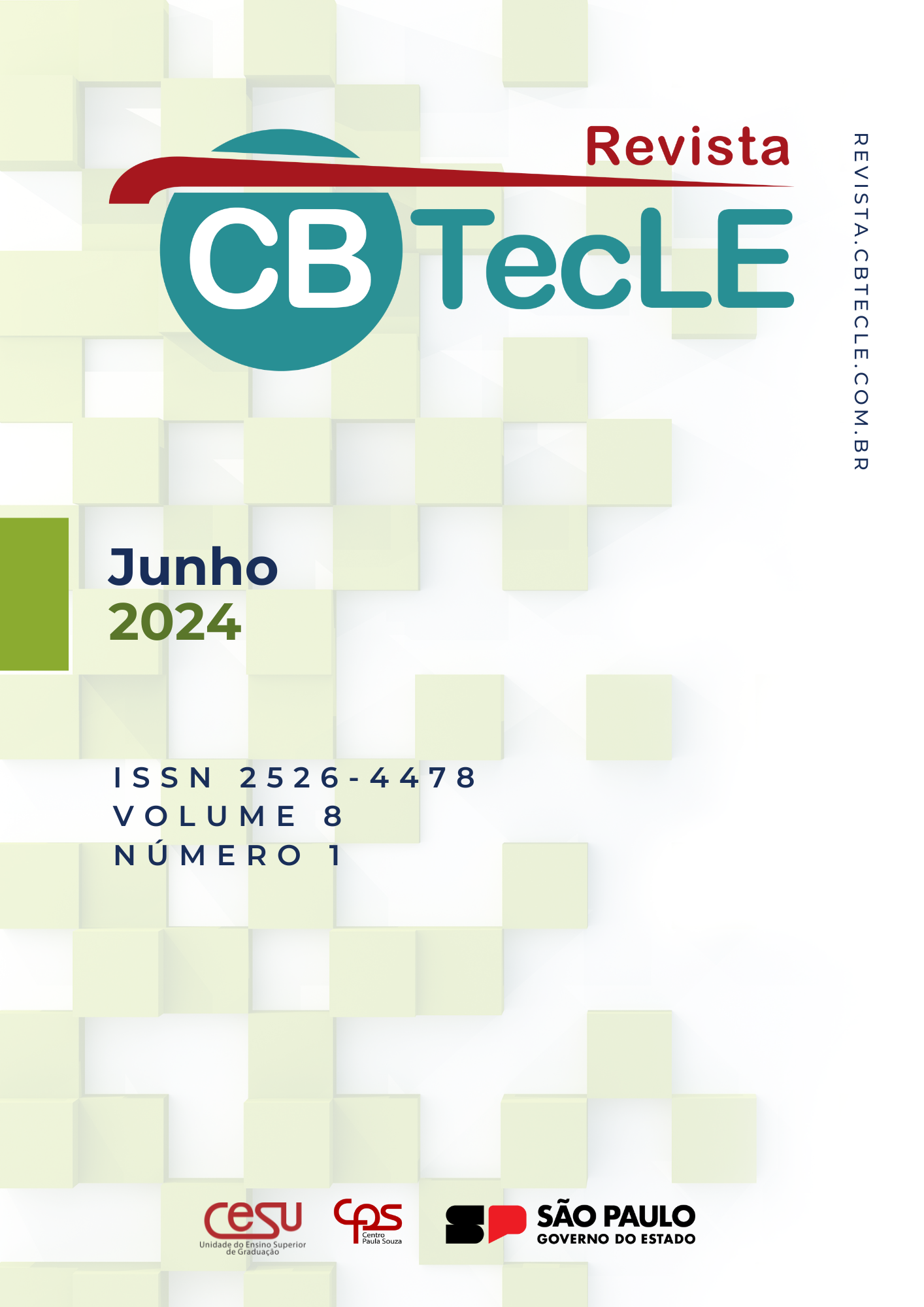THE INCLUSION OF LITERARY TEXT IN SÍNTESIS TEXTBOOKS, BY IVAN MARTIN, FOR TEACHING THE SPANISH LANGUAGE
Keywords:
Reading strategies; literary text; language teaching.Abstract
This research aims to analyze the material that was used by the Center for Language Studies, in the State of São Paulo, to determine whether it works with literary works with the aim of addressing the cultural aspects present in the text, as well as proposing debates, discussions, reflections and socializations on the themes covered in the excerpts chosen by author Ivan Martín in his collection of textbooks entitled Síntesis. The methodological procedure consists of two stages: the first corresponds to the bibliographical review and the study of theoretical assumptions about reading, the literary text and the role of the reader in the literary text, based on Solé (1998); Kleiman (2011); Soares (2011). The second stage proposes an analysis of the works cited in the book, as well as the statements of the exercises proposed to work on literary aspects, through studies by Widdowson (1984); Mendoza (2007) and SOUZA (2008). As a result, it appears that the teacher needs to assume the role of mediator to outline the objectives he wants to achieve; This way, you will be able to understand how students receive literary work and this facilitates the entire teaching and learning process.
References
AGUIAR, V.T.de. Que livro indicar? Interesses do leitor jovem. Porto Alegre: Mercado Aberto, 1979.
________. Leitura literária e escola. In: EVANGELISTA, A. (org) Escolarização da leitura literária: o jogo do livro infantil e juvenil. 2 ed. Belo Horizonte: Autêntica, 1996, p.235-255. ________. Literatura: a formação do leitor – alternativas metodológicas. Porto Alegre: Mercado Aberto, 1988.
ALBERTI, P.B. Contos de fadas tradicionais e renovados: uma perspectiva analítica. Caxias do Sul, 2006. 129p. Dissertação (Mestrado em Letras e Cultura Regional) Universidade de Caxias do Sul, 2006.
ANDRÉ, M. E. D. A. Estudo de caso em pesquisa e avaliação educacional. Brasília: Líber Livro, 2005. (Série Pesquisa, 13)
ARROYO. L. Literatura infantil brasileira. São Paulo: Melhoramentos, 1967.
ASBAHR, S.F. Leitura e Produção de texto (2009 – 2011): a efemeridade dos projetos de leitura literária na rede estadual paulista. São Paulo, 2013. 164 p. Dissertação (Mestrado em Educação) Universidade de São Paulo, 2013.
BAMBERGER, R. Como incentivar o hábito da leitura. 7 ed. São Paulo: Ática, 2004.
BRASIL. Linguagens, códigos e suas tecnologias / Secretaria de Educação Básica. – Brasília : Ministério da Educação, Secretaria de Educação Básica, 2006.
BRANDÃO, H. N.; MICHELETTI, G. Teoria e prática de leitura. In: Aprender e ensinar com textos didáticos e paradidáticos. São Paulo: Cortez, 1997.
CANDIDO, A. Literatura e sociedade. São Paulo: Companhia Editora Nacional, 1985.
__________ Direitos humanos e literatura. Comissão de Justiça e Paz. São Paulo: Brasiliense, 1989.
JOUVE, V. A leitura. São Paulo: Unesp, 2002.
__________ A história da literatura como provocação à teoria literária. Trad. de S. Tellaroli. São Paulo: Ática, 1994.
KLEIMAN, A. B. (Org.). Os significados do letramento. Campinas: Mercado das Letras. 2011.
KÜGLER, Hans. A recepção do texto literário no ensino: uma experiência com a poesia. Revista Diálogo Educacional. Curitiba, v. 5, n. 16, p. 95-104, set/dez. 2005.
_______. Níveis de Recepção Literária no Ensino. Literatur under komunikation. Stuttgart: Ernest Keett, 1971. Tradução livre de Carlos E. Fantinati. In: MARTHA, A. A. P. e outros. O ensino da literatura. Relatório de pesquisa, 1987.
LAJOLO, M. Literatura: leitores e leitura. São Paulo: Moderna, 2001.
___________. Do mundo da leitura para a leitura do mundo. São Paulo: Ática, 1993. 115
____________. O texto não é pretexto. In: ZILBERMAN, Regina. Leitura em crise na escola (org). Porto Alegre: Mercado Aberto, 1993.
____________; ZILBERMAN, Regina. Literatura infantil brasileira – história e histórias. 5 ed. São Paulo: Ática, 1991.
_______. O texto não é pretexto. In: AGUIAR, V.T. (org) Leitura em crise na escola: as alternativas do professor. 2 ed. Porto Alegre: Mercado Aberto, 1982.
MARTÍN, I. Síntesis - Curso de Lengua Española, VOL1. Ed. Ática, 2010.
MARTÍN, I. Síntesis - Curso de Lengua Española, VOL2. Ed. Ática, 2010.
MARTÍN, I. Síntesis - Curso de Lengua Española, VOL3. Ed. Ática, 2010.
MICCOLI, L. Experiências, crenças e ações: uma relação estreita na sala de aula de LE. In: SILVA, K. A. Crenças, discursos e linguagem. Vol. I. Campinas, SP: Pontes Editores, 2010b , p. 135-165.
MONTES A, S. & GARRIDO, A. La literatura en la clase de lengua. In: S. Montesa Peydró y A. Garrido Moraga (Eds.). Español para extranjeros: didáctica e investigación. Actas del II Congreso de ASELE. Málaga: ASELES, 1994. p. 449-457.
NAVARRO, M. V. La lectura en la clase de español en los niveles principiante- intermedio: ¿misión imposible? IZ München, 2006. Disponível em: . Acesso em: 10 fev. 2012.
PAIVA, V. M. O. A LDB e a legislação vigente sobre o ensino e a formação de professor de língua inglesa. In: STEVENS, C. M. T.; CUNHA, M. J. C. (Orgs.) Caminhos e colheita: ensino e pesquisa na área de inglês no Brasil. Brasília: Editora da UnB, 2003, p. 53-84.
PERIS, E. M. Textos literarios y manuales de enseñanza de español como lengua extranjera. In: Lenguaje y textos, n. 16. Universidade da Coruña, 2000. p. 101-129.
PIETRI, E. Práticas de leitura e elementos para a atuação docente. Rio de Janeiro: Lucerna, 2007.
SANTOS, A. C. El texto literario y sus funciones en la clase de E/LE de la teoría a la práctica. In: Anuário brasileño de estudios hispánicos, n. 1. Embajada de España en Brasil. Madrid: Consejería de Educación. p. 33-45, 2007.
SOARES, Magda. Letramento: um tema em três gêneros. 2. ed. 10. reimpr. Belo Horizonte: Autêntica, 2005. SOLÉ, Isabel. Estratégias de leitura. Porto Alegre: Artmed, 1998.
WIDDOWSON, H. G. The use of literature. In: WIDDOWSON, H. G. Explorations in applied linguistics 2. Oxf



